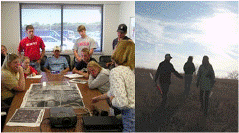Environmental and Sustainability Studies Program

Department of Environmental Studies: Undergraduate Student Theses
Date of this Version
5-9-2022
Document Type
Thesis
Citation
Environmental Studies Undergraduate Student Thesis, University of Nebraska-Lincoln, 2022
Abstract
Allelopathy is a description of an interaction between two plant species, usually negative, that impacts their growth or germination. There has been ample data published regarding the impact of allelopathic species in agricultural settings, but little attention has been given to the potential interactions between invasive and native species. Two culprits that have employed allelopathy to great effect in agricultural settings are cheatgrass (Bromus tectorum) and giant foxtail (Setaria faberi). This study posits that allelopathic interactions, similar to those found in agriculture, are occurring between native and invasive species on the Great Plains.
A set of greenhouse trials was established to determine the effects of interplanting of native and invasive species (simulating the annual fight for germination and resources in Spring). The invasive species biomass was harvested after 6 weeks for the second set of trials, set to simulate native species germinating under last season’s growth of invasive tissue. This scenario is common in the grasslands of Nebraska, where germination often occurs under the dead foliage of last season’s growth.
In examining the interactions between the two invasive species, described above, and two native species, sunflower (Helianthus annuus) and black eyed susan (Rudbeckia hirta), it was found that there were small differences between the control and experimental populations. Vigor and speed of development was negatively impacted in both Rudbeckia and sunflower, likely due to interspecies competition. Both invasive species showed a deleterious effect on native plant growth compared to the control. There was no impact on germination or growth in the trials with dead invasive biomass spread over the surface of the soil.
Included in
Environmental Education Commons, Natural Resources and Conservation Commons, Sustainability Commons


Comments
Copyright 2022, Nash Leef